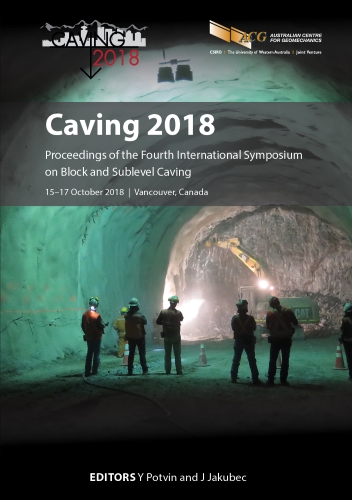InSAR as a practical tool to monitor and understand large-scale mining-induced ground deformations in a caving environment

|
Authors: Makitaavola, K; Stockel, B-M; Savilahti, T; Sjoberg, J; Dudley, J; McParland, MA; Morin, R |
DOI https://doi.org/10.36487/ACG_rep/1815_51_Sjoberg
Cite As:
Makitaavola, K, Stockel, B-M, Savilahti, T, Sjoberg, J, Dudley, J, McParland, MA & Morin, R 2018, 'InSAR as a practical tool to monitor and understand large-scale mining-induced ground deformations in a caving environment', in Y Potvin & J Jakubec (eds), Caving 2018: Proceedings of the Fourth International Symposium on Block and Sublevel Caving, Australian Centre for Geomechanics, Perth, pp. 661-674, https://doi.org/10.36487/ACG_rep/1815_51_Sjoberg
Abstract:
The application of InSAR technology to monitor mining-induced deformations has been successfully applied at the Kiruna mine site for more than seven years. Ground deformations are caused by the use of large-scale sublevel cave mining to extract iron ore from the underground Kiirunavaara mine. More recently, InSAR monitoring has also been applied at the nearby LKAB Malmberget mine site, also mined using sublevel caving. In both cases, the induced ground deformations are affecting existing infrastructure, necessitating an urban transformation process to relocate surface infrastructure and/or residential areas. Control and follow-up of ground deformations has thus become vital, and InSAR monitoring has proven to play an ever-increasingly important role in this. The technique and its use at a high-latitude (snow-covered) site, and for LKAB's specific purposes, was initially investigated and verified during a five-year research project. A slightly expanded monitoring program is now in place in Kiruna, which supplements the standard GPS monitoring. At Malmberget, InSAR monitoring has enabled verification of the overall movement trends with respect to major shear structures in the area. Additionally, increased reliability in areas with poor GPS coverage has been achieved, as well as increased data coverage in periods between GPS measurement campaigns. Combined use of InSAR and GPS data has also helped to calibrate and constrain numerical models, as exemplified in this paper. Work is now ongoing to implement the use of InSAR to monitor the criterion for allowable ground deformations at both sites, as well as in integrated interpretation of caving mechanics and deformations.
Keywords: sublevel cave mining, mining-induced ground deformations, remote sensing
References:
Henschel, M, Dudley, J, Lehrbass, B, Sato, S & Stöckel, B-M 2015, ‘Monitoring slope movements from space with robust accuracy assessment’, Proceedings of the 2015 International Symposium on Slope Stability in Open Pit Mining and Civil Engineering, The Southern African Institute of Mining and Metallurgy, Johannesburg, pp. 151–160.
Itasca Consulting Group, Inc. 2016, 3DEC, version 5.20, computer software, Itasca Consulting Group, Inc., Minneapolis, https://www.itascacg.com/software/3dec
Magnor, B & Mattsson, H 2010, Strukturgeologisk Modell Över Malmbergets Gruvområde, final report to LKAB, GeoVista, Luleå, and Hifab, Stockholm, in Swedish.
Mäkitaavola, K, Stöckel, B-M, Sjöberg, J, Hobbs, S, Ekman, J, Henschel, M & Wickramanayake, A 2016, ‘Application of InSAR for monitoring deformations at the Kiirunavaara mine’, in HS Mitri, S Shnorhokian, MK Kumral, A Sasmito & A Sainoki (eds), Proceedings of the 3rd International Symposium on Mine Safety, Science and Engineering, McGill University, Montreal, pp. 133–139.
Sjöberg, J & Savilahti, T 2014, ‘Caving in the Fabian orebody from mining stope to cave crater in Malmberget’, Proceedings of the 8th Asian Rock Mechanics Symposium: Rock Mechanics for Global Issues – Natural Disasters, Environment and Energy, Japanese Committee for Rock Mechanics, Tokyo, pp. 1421–1430.
Vatcher, J, McKinnon, S & Sjöberg, J 2016, ‘Developing 3-D mine-scale geomechanical models in complex geological environments, as applied to the Kiirunavaara Mine’, Engineering Geology, vol. 203, pp. 140–150.
Wickramanayake, AAB, Mahapatra, P, Buehler, SA, Ekman, J, Hobbs, S & Mendrok, J 2015, ‘Comparison between Static-GPS and corner reflector InSAR (CR-InSAR) measurements at a high latitude site’, submitted for publication.
Wickramanayake, AAB, Henschel, MD, Hobbs, S, Buehler, SA, Ekman, J & Lehrbass, B 2016, ‘Seasonal variation of coherence in SAR interferograms in Kiruna, Northern Sweden’, International Journal of Remote Sensing, vol. 37 no. 2, pp. 370–387,
© Copyright 2025, Australian Centre for Geomechanics (ACG), The University of Western Australia. All rights reserved.
View copyright/legal information
Please direct any queries or error reports to repository-acg@uwa.edu.au
View copyright/legal information
Please direct any queries or error reports to repository-acg@uwa.edu.au
